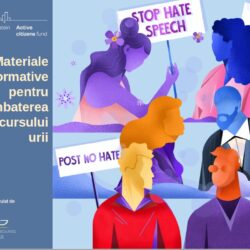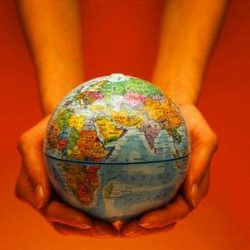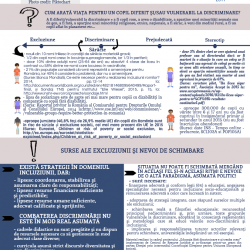Education for Inclusion Starts with the Kid with Disabilities' Family
I’ve spent the past eight years trying to figure out a way of leaving the house without the raging bull look. The rare moments of finding the way were always followed by a crushing wave of”whys” which inevitable converged into periods of depression. The variable that determines the length of these periods is given by: some meaningful/significant syllables, putting two cubes one over the other or recognizing one’s own clothes. Small meaningful acquisitions for which our children work tens of hours. Furthermore, depression is one of the things that people like me receive together with their child’s diagnosis: vegetable, retarded, autistic, and handicapped – all for the rest of their lives.
For those who don’t know what I’m talking about, Raging Bull is a film starring De Niro and Joe Pesci, directed by Scorsese. It’s a movie about a professional boxer with a violent temper, a trait that helps him become one of the best in the ring. Psychologists would say that he has some emotional wound inside him. I would say he definitely has a child with disabilities.
It is often said about us, the parents of special needs children, that we are ”brave”, ”strong”, that we tear up the world in two and reshape it for our kids. There are also many that see us as being savage, violent, moody, or on the contrary, too sensitive. We are all of these together and more, we are De Niro cast in Raging Bull, directed by Sergiu Nicolaescu. As in a bad joke. We go out with our child like getting into a boxing ring; „we have to come home unharmed`„is the only thought on our mind. The street that I used to walk on, going to pub, to a release, at a meeting. It’s both pathetic and real.
How I got to be part of ”the others”
I’ve been trying for eight years to figure out how to give up the raging bull look in my eyes. I want to figure out how I managed to let so much rage grow inside me. I want to know where did my will to smile disappear; why I no longer go to the park; why I avoid playgrounds; why, after all this time, it still hurts to not be invited to any birthday party. I don’t want to be a raging bull; however, I this is what I am. I respond to aggressiveness with aggressiveness, to ugly glances with bloodshot eyes, to pitiful whispers with aversion. This is where the wave of whys, that I was telling you about at the beginning, comes into play. And then the depression, they come in circles.
I’ve written a lot about children and about special needs in the last eight years, since I myself became the mother of a child suffering from an intellectual disability, nonverbal disability, with sensory processing disorder, and dwarfism. In a nutshell, the mother of a special needs child. I’ve been writing in order to explain to myself, above all, how I could suddenly land in the boxing ring. How was it possible that I would be the one to bear a child with disabilities? When I was a kid, these children came from dysfunctional families, their parents being drunks or drug addicts, they were the children from orphanages and slums, they weren’t our children, the ”quality people”, the good girls with prizes and decorations. They were the children to whom we used to give the clothes that wouldn’t fit us anymore, the children that our grandmother, mother or aunt used to talk about weeping pitifully for a few minutes. They were ”the others”.
Nowadays I am ”`the others”. I’m trying to understand how I got here. This is the first time I wonder who made this separation between ”us” and ”the others”. When you find yourself in the safe zone of the healthy families, this separation between us and the others seems natural. Passing to the other side is something that happens suddenly, finding you unprepared, and it takes somewhere around three seconds, the time it takes for the doctor to give you the diagnosis: he will be a vegetable, with the variations: he’s autistic, retarded, a wreck. There are some cases when it takes even less, because putting one’s finger near the head to symbolizemental retardation is a gesture with a diagnosable connotation, which takes only one second from those three you have. These three seconds take you on the ”other side”. Faster than it takes you to get to Narnia. You get into the office through here and you get out through there, even if you don’t understand it really well, you figure it out from the double dealer look of the doctor.
It takes you days, maybe months to recover from the shock and you realize that in three seconds many things were being decided for yourself and everything that you once saw as certain is no longer . The soil under your feet turned into quicksand which tries to swallow you from time to time. You realize that you are alone. Here – there. Then – Now. You bounce back from the shock and look in the mirror just to discover the raging bull look. You don’t recognize yourself.
I’ve borrowed my child’s disability
Together with his child’s diagnostic, the parent becomes a disabled person as well. In the cases of the neurotypical children, with the years passing their relationship with the parent broadens and the child becomes more and more independent, so that the adult regains his ”freedom” and leisure time; but for the families of the children with special needs the dynamics is different, being characterized by involution. Whether we are talking about an intellectual disability or just a physical one, these children often stay near their parents forever, being in need of the type of caring that is offered to a toddler. The reconfigured family of a kid with disabilities needs to adapt to this reality. But this could take years. And in this context oftentimes the social isolation comes into play. ”Maybe the most insidious stress factor (for the families of disabled children n.a.) is social isolation resulted from the retraction of friends or, on the contrary, the retractionof the parents that are being confronted with pity or lack of understanding from their friends. When a healthy child is born the social network of the parents expands, while in the cases of children with disabilities, this same network contracts. (Andrew Solomon, ”Far from the Tree: Parents, Children and the Search for Identity”).
Solomon discusses the problem of the double retraction – from the parent’s side and from society’s side. In order for people with disabilities living in Romania to live at a decent level in a so called inclusive society, one needs to have the guts to turn around and look the other in the eye, no matter what this ”other” means for every one of us. From my point of view, as the parent of a child with special needs, I feel that we should try to give up the raging bull look, even just for a few minutes a day. To make the first step towards ”the others”. We need to apply on our own social”disability” the therapeutic methods that we exercise each day at home. Hundreds and hundreds of hours invested in learning once again to exist socially, for us and for our child.
An inclusive society begins with the family of the children with special needs
An inclusive society is our children’s right. An inclusive society is in principle largely unknown to those who do not have a disabled person in their proximity. For them, inclusion means periodically giving away clothes and toys, it means the pitiful glance, it means special schools, it means therapy centres about which they can’t know that sometimes don’t function accordingly, it means a ton of questions when they meet us on the street or a hundred practical aspects that they don’t know, it means the fear that it could happen to them. It’s the same fear that weourselves felt in those 3 seconds when the diagnosis was given. The horror of becoming the”others”. The ”others” need to know us and understand our reality in order to be on our side.
A society that can accept our children is one that we managed to accept as is, fear reactions included. Only by accepting it we can be able to think about coherent and useful actions meant to help them. Our isolation and lack of tolerance cannot be a very good lawyer for our pro-inclusion amendments. We can’t demand tolerance, understanding and empathy if we can’t be able to show them these things.
I don’t want to be a raging bull, yet I am. I offer aggressiveness and I receive aggressiveness. While trying to redefine myself as the parent of a kid with disabilities, I started reading everything that I could find on the internet under the keyword ”discrimination”. I found out that I was xenophobic, narrow minded, that I divided the world using criteria such as ethnicity, sexual orientation or religion. ”Not that seriously”, more like avoiding some types of people or certain places. Nothing ”severe”. And yet, these reactions and attitudes hurt me a lot when they are targeted towards my daughter. We are promoting an education for discrimination, for the perfect human, even though we know that such a thing doesn’t exist. We carry behind us generations of grandmothers, mothers and aunts that whispered syrupy or mockingly about the people like us. We find it hard to react otherwise, ”betraying” those who educated us.
We have to become the voices of our children
The main advantage that we have as parents of children with disabilities is that we have double citizenship. We are ”here”, but we have also been ”there”. We can choose to understand the other one, the one that stares at our child. We understand how they thinks, what are the basis of their exclusive reactions, what they are afraid of. We can talk about our world in their tongue.
The first step that needs to be taken for an environment that accepts diversity is the one we should take; to accept as ourselves as ”the others”, the ones that we became in those 3 seconds. To exercise tolerance by looking in the mirror – first for the new ”me”, and then for those around us. We must, WE MUST become the walking billboard for our children. We have access to media resources that give us the freedom of speech. We have to tell the people about our children’s lives, fights and little victories.
We have to talk for them, to make them known as living and real persons, not just as mere semiconscious objects that we drag after us every day or keep closed in our homes.
In 1974, Marina Abramović held an experimental performance art show – Rhythm 0. Describing herself as an ``object``, the artist invited the public to use on her body any of the 72 objects that she prepared, among which was a gun with one bullet inside, in any way they wanted, without her interfering, exactly as an inanimate object. During the six hours of performance, the public divided into those who chose to harm her and those who protected her, the performance show ending with one visitor who held the loaded gun in her direction. This experiment, as extreme as it may seem, actually shows us our capacity of hurting those we consider inanimate, an object, something less than human. And the recent history of mass extermination confirms it.
Education for inclusion and tolerance begins with us and with the way we present our children with disabilities to the world: like living persons, able to be happy, sad, and have dreams. Encourage those around you to ask about their favorite food and clothes; about the music they like to listen to, their favorite season or about the things that frighten or bother them.
I needed eight long years before I started wanting to replace the raging bull look with the serene one. To try to understand by myself the diversity of points of view, even if this would mean to live near those that don’t want my child alongside them. To hope and to fight. To speak up for my child. Come and talk to me, ask me things, I will answer!
by Ruxandra Mateescu
Ruxandra Mateescu- initiator and coordonator of the project Superheros among us which promotes social iclusion for people with special needs through personal stories. She is the mother of three children, among whom a daughter with disabilities; she writes extensively about life with her daughter, about acceptance and about social rights. She believes in the power of positive examples, except on days when she wishes she were Sfarmă-Oase.









